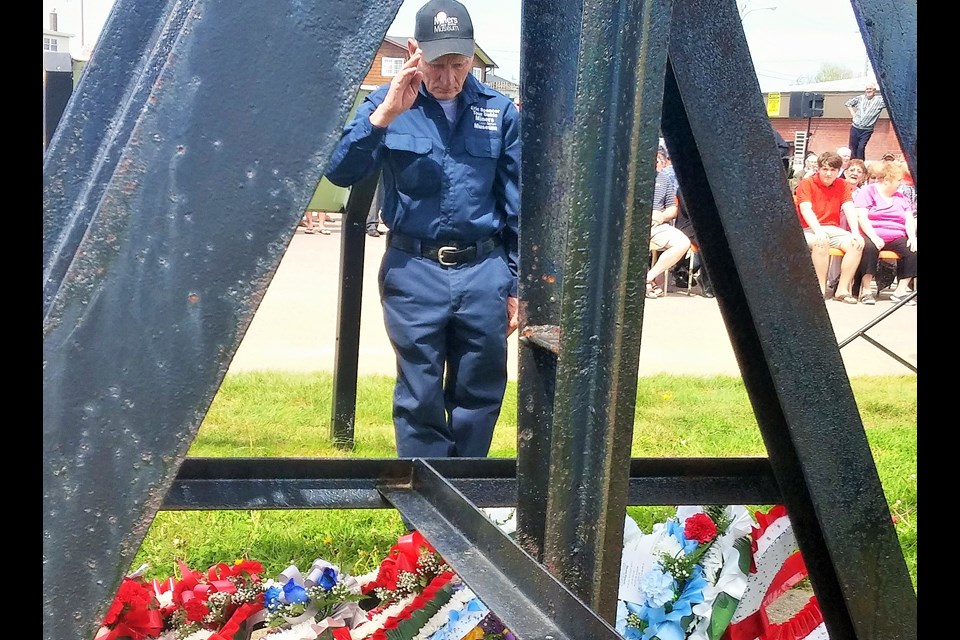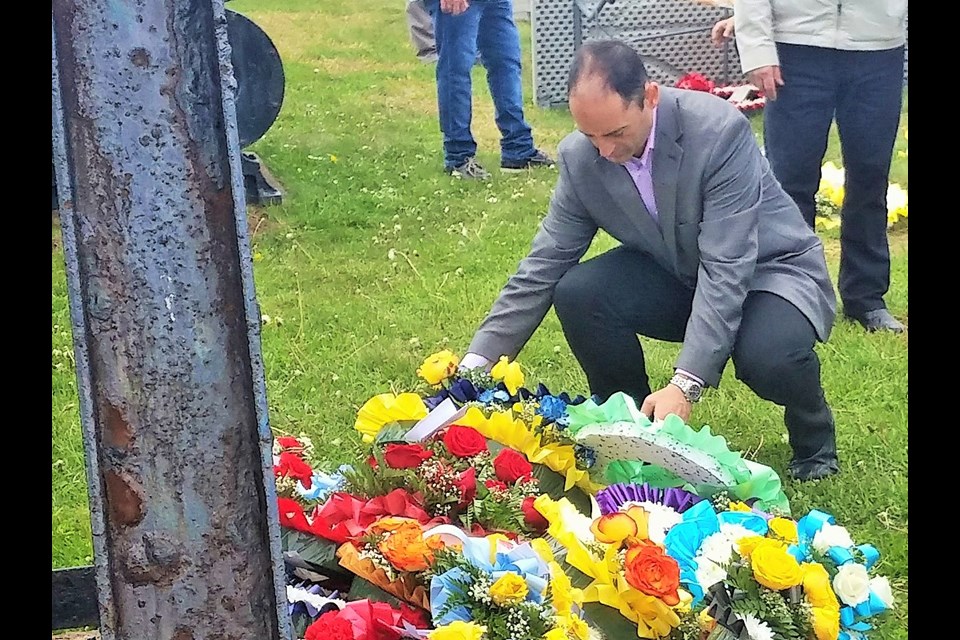Hundreds Honor Coal Miners' Sacrifices at Davis Day Ceremony in Nova Scotia, Canada

By Tom Ayers
June 11, 2017 - Workers at the newly opened Donkin coal mine in Canada will be unionized within a year, Bob Burchell told hundreds of people gathered at the Cape Breton Miners Museum on William Davis Miners' Memorial Day.
"I hope that mine becomes a good, productive mine, and a safe mine, and it's no secret the United Mine Workers will be out there trying to organize, and not to be a thorn in the side of the company but to work with the company, and to make sure that the men going to work each day come home safely, and they work in a safe environment," said Burchell, who retired earlier this year as international representative for United Mine Workers of America.
"If there's any miners from Kameron Collieries here, I want you to know ... when you come with us, and when you come back here next year, you'll be coming here on a paid holiday."
Burchell, who has hosted Davis Day ceremonies in Glace Bay and New Waterford for years, said despite retirement he will continue to host future ceremonies and the union will continue to support the event, which is held every June 11 to honour miners who have died on the job in Nova Scotia.
It is named after William Davis, a 37-year-old coal miner who was shot and killed by coal company police on that date in 1925 outside New Waterford, where striking miners were marching to try to have power and water restored after the company cut off the miners and their families.
For the first time in the three years since the Donkin mine was purchased by Kameron Collieries, a subsidiary of U.S. coal giant Cline Group LLC, a company representative attended Davis Day.
The mine started producing coal earlier this year and is ramping up towards full production, when it is expected to employ up to 130 people.
Shannon Campbell, the mine's general manager and a native of South Bar, just outside Sydney, laid a wreath at the foot of a giant bull wheel that used to lift the elevator at the No. 26 colliery in Glace Bay.
He declined to be interviewed, saying the Davis Day ceremony should remain the focus of the day.
In an interview with reporters, Burchell later expanded on his vow to organize workers at Donkin mine.
"I just spoke with the mine manager there and I told him look, we're not in the business of putting mines out of business," said Burchell. "We're in the business of making the mines prosper, with the knowledge that our workers are going to be safe and get to go home every night.
"And we will be going in to unionize that mine, and hopefully we'll be successful and have a good working relationship."
Kameron Collieries' parent company in the U.S. has been the subject of safety concerns in the past, although Nova Scotia officials say the Donkin mine is being watched carefully by provincial regulators.
Cline Group mines are known for being non-union workplaces, but Burchell said he's hoping the Donkin mine will be the first, "and I'm hoping that it'll open their eyes that it's not a bad thing to be union, especially in the mining industry."
Coal has been dug on Cape Breton Island for hundreds of years. The first coal was taken out of the cliffs around Port Morien, just down the coast from Donkin, for use at the 18th-century French Fortress of Louisbourg.
In the 1980s, the Cape Breton Development Corp., a federal Crown corporation known as Devco, drove two slopes into the Donkin coal seam 3.5 kilometres under the Atlantic Ocean off a peninsula near Schooner Pond, southeast of Glace Bay.
However, the price of coal fell and the mine never opened. By 2001, the federal government had shut down the last of the underground mines on the island.
The United Mine Workers have continued to staff an office in Glace Bay since then, and Burchell said that tradition will carry on.
During a sermon earlier in the day inside the Miners Museum, Rev. Duncan Roach of Calvin United Church in New Waterford said more than 1,300 men died in Cape Breton coal mines over the decades, with 12 lives lost in the last underground explosion in No. 26 colliery in Glace Bay in 1979.
"We gather together in this place — this sacred place — and this time to remember William Davis and all fallen miners over the years," he said. "And we do so as a sign of our growth, as a sign of our tradition, a sign of our history.
"We respect and we honour what they stood for and what they gave with their lives.
"Coal mining involves deep workings, soft rock, dust, poisonous inflammable gases, explosives, machinery, ventilation systems, and each of these has been a factor in the many Cape Breton coal mining tragedies."
Later, Nova Scotia Federation of Labour president Danny Cavanagh, whose grandfather was killed in a mine explosion at Stellarton in 1935, asked the crowd to imagine what it must have been like a decade before that for Davis and the hundreds of miners who were being starved out of their homes by the coal company.
"Imagine a company that wants to cut off your credit, shut off your water, and take to violence in the streets with guns," he said.
"We're lucky we don't face those kinds of things today, but that's the history that the trade union movement and others can never forget, and we will never forget, because of the work that the United Mine Workers do every year upon this day.
"Today speaks powerfully to our commitment to the rights of workers and of workplace safety. The dangers of mining are many, and when you look back at the history of mining disasters in Canada and Cape Breton and Nova Scotia, miners have paid a dear price."
A couple of dozen wreaths were laid at the foot of the bull wheel by union representatives, former miners, politicians and descendants of William Davis.
One of the wreaths was laid by Eric Spencer, a former coal miner and current employee at the Miners Museum who wished to honour Sheldon McNeil, a co-worker in the mines and at the museum who died recently at the age of 71.
Spencer said he and McNeil knew the bull wheel well, having both worked in No. 26 colliery and several other mines in the Glace Bay area.
They also both took many tour groups underground at the museum over the last 10 years.
Spencer said the Davis Day ceremony was emotional for him on a number of levels.
"One of my jobs here when I take a tour group down is to explain the history of coal mining, and the story of Mr. Davis is the most important part that we tell the tourists about," he said.
"The sacrifices that the miners worked under in early conditions when they first came over here, and how we learned to stick together, stay together and overcome."
In his obituary, Sheldon McNeil was described as a passionate coal miner, a strong advocate for unions and a busy volunteer with local organizations.
McNeil was a wonderful friend and colleague, said Spencer, and it was an honour to lay a wreath in his name.
"If Sheldon died of a heart attack ... it was because his heart was too big," Spencer said.

Former coal miner Eric Spencer, seen through the spokes of a bull wheel at the Cape Breton Miners Museum in Glace Bay, Nova Scotia, lays a wreath in honour of his friend and co-worker Sheldon McNeil, who recently died.
Photo by Tom Ayers, Local Xpress

Shannon Campbell, a Cape Breton native and the general manager at Kameron Collieries' new coal mine in Donkin, lays a wreath during Davis Day ceremonies at the Cape Breton Miners Museum in Glace Bay, Nova Scotia.
Photo by Tom Ayers, Local Xpress

